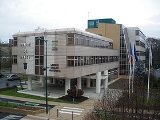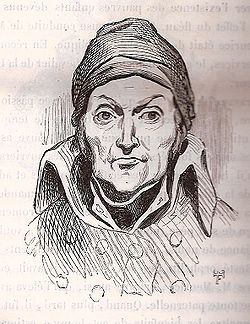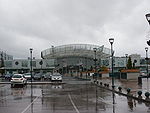
Massy
Encyclopedia
Massy is a commune
in the southern suburbs of Paris
, France
. It is located 14.7 kilometres (9.1 mi) from the center of Paris
.
The inhabitants of Massy are known as Massicois.
and RER line C
: Massy – Verrières
and Massy – Palaiseau.
There is also a TGV
station, called Massy TGV
, which is adjacent to Massy – Palaiseau station and is one of only three specially-built TGV stations in the suburbs of Paris (the two others are at Disneyland Resort Paris
and at Charles de Gaulle International Airport
).
During the Middle Ages and until the end of the Ancien Régime, the lordly estates divided up the territory of the current commune, assigning a majority part to the ecclesiastical institutions and in particular the abbey of St-Germain-des-Prés. In the 10th century, the line of the lords of Massy was established; their title of nobility was to become a barony (nowadays the Grimaldi-Monaco family)..
Before 1900, the history of the city was similar to that of the rural boroughs of Ile-de-France. After the Revolution, the town remained rural. The population followed an evolution identical to that of the rest of the region. It underwent the same wars, epidemics and rebellions. The massicois practiced mainly agricultural trades (gardeners, vine growers), even if local arts and crafts were always present. The tile factory, abandoned after the Second World war, was the town's oldest industry.
It is with the beginning of the 20th century that the face of Massy changes: from being a rural village, it transforms into a town increasing subjected to the attraction of Paris. Once with a population of just 1,400 people, nowadays, the town of Massy holds almost 40,000 inhabitants. At the end of the 19th century, the development of railways supported the construction of industries. The first allotments were born at the beginning of the century. The citie's urbanisation developed towards the districts of the Gravels and Villaine, where it was necessary to establish a school as early as 1927. It is the era of the “suburban house”.
During the Second World War, the marshalling yard of Massy-Palaiseau was considered a strategic rail junction. The bombardments of these infrastructures caused 88 victims and material damage throughout the town. In the post-war period, the reconstruction and development of the parisian agglomeration and its suburbs metamorphosed the town's geography. The housing crisis provoked an outrage, thus the "castor" movement established some residences in the east of the city. The establishment of a housing scheme on 145 hectares of the communes of Massy-Antony caused the population of Massy to double. The creation of a 'Priority Construction Zone' in Villaine 10 years later was intended to even out the town's urbanisation. This abrupt development of the town also modified its social structure: rejuvenation of the population, arrival of foreigners, etc. During the 1960s and 1970s, questions are raised about rapid urban development: housing problems and shantytowns, lack of public resources, requalification of certain factory sites, delinquency, etc. To satisfy the needs for this new population, many new infrastructures were created such as schools, hospitals, sports centres, swimming pools, arts centres, nurseries and parks. The establishment of a TGV
station in 1991 is an asset for the economic development of the city. Nowadays, certain amenities have an influence which exceeds the communal and departmental circles, in particular opera and theatre. (Author: Municipal archives of Massy)
The canton of Massy-Est contains 18,316 inhabitants;
The canton of Massy-Ouest contains 19,396 inhabitants.


Communes of France
The commune is the lowest level of administrative division in the French Republic. French communes are roughly equivalent to incorporated municipalities or villages in the United States or Gemeinden in Germany...
in the southern suburbs of Paris
Paris
Paris is the capital and largest city in France, situated on the river Seine, in northern France, at the heart of the Île-de-France region...
, France
France
The French Republic , The French Republic , The French Republic , (commonly known as France , is a unitary semi-presidential republic in Western Europe with several overseas territories and islands located on other continents and in the Indian, Pacific, and Atlantic oceans. Metropolitan France...
. It is located 14.7 kilometres (9.1 mi) from the center of Paris
Kilometre Zero
In many countries, Kilometre Zero or similar terms in other languages, is a particular location , from which distances are traditionally measured...
.
Population
Massy underwent rapid development within a short period of time, transforming from a large borough of 6000 inhabitants in 1950 to a town exceeding 37000 inhabitants in 1968. Since then, its population of around 40000 has remained relatively stable.The inhabitants of Massy are known as Massicois.
Transport
Massy is served by two interchange stations on Paris RER line BRER B
The RER B is one of the five lines in the RER rapid transit system serving :Paris, France.The line runs from the northern termini Aéroport Charles de Gaulle and Mitry-Claye to the southern termini Robinson and Saint-Rémy-lès-Chevreuse ....
and RER line C
RER C
The RER C is one of the five lines in the RER rapid transit system serving :Paris, France. It is operated by SNCF.The line runs from the northwestern terminuses Pontoise , Versailles – Rive Gauche and Saint-Quentin-en-Yvelines to the southeastern terminuses Massy-Palaiseau , Dourdan-la-Forêt , ...
: Massy – Verrières
Massy-Verrières
Massy-Verrières is a station of the Île-de-France RER, located in Massy, at the junction of RER B and RER C . Its station is nearby Verrières-le-Buisson.image:RER-B MassyV1.jpg|RER C stationimage:RER-B MassyV3.jpg|RER B station...
and Massy – Palaiseau.
There is also a TGV
TGV
The TGV is France's high-speed rail service, currently operated by SNCF Voyages, the long-distance rail branch of SNCF, the French national rail operator....
station, called Massy TGV
Gare de Massy TGV
Massy TGV is a TGV railway station in Massy, France. Massy TGV is a new station, located in Île-de-France, was built for the LGV Atlantique. Thus certain trains serve at Montparnasse Station and this station simultaneously, although it is not allowed to use the TGV for such a short distance...
, which is adjacent to Massy – Palaiseau station and is one of only three specially-built TGV stations in the suburbs of Paris (the two others are at Disneyland Resort Paris
Disneyland Resort Paris
Disneyland Paris is a holiday and recreation resort in Marne-la-Vallée, a new town in the eastern suburbs of Paris, France. The complex is located from the centre of Paris and lies for the most part within the commune of Chessy, Seine-et-Marne....
and at Charles de Gaulle International Airport
Charles de Gaulle International Airport
Paris-Charles de Gaulle Airport , also known as Roissy Airport , in the Paris area, is one of the world's principal aviation centres, as well as France's largest airport. It is named after Charles de Gaulle , leader of the Free French Forces and founder of the French Fifth Republic...
).
History
The etymological origin of Massy is still very dubious. This name could result from the name of an owner of a villa of the Gallo-Roman time, original site of the village. Called Matius or Matheus, the name of his property then village would have been subjected to deformations due to language and the passing of time to become Massy. Located near the road between Paris and Chartres, the villa was undoubtedly built on a height (the Gaudon Mount) and formed the starting point of a human establishment. The argillaceous subsoil explains the formation of a clearing within the forest and the numerous stretches of water in the surrounding area.During the Middle Ages and until the end of the Ancien Régime, the lordly estates divided up the territory of the current commune, assigning a majority part to the ecclesiastical institutions and in particular the abbey of St-Germain-des-Prés. In the 10th century, the line of the lords of Massy was established; their title of nobility was to become a barony (nowadays the Grimaldi-Monaco family)..
Before 1900, the history of the city was similar to that of the rural boroughs of Ile-de-France. After the Revolution, the town remained rural. The population followed an evolution identical to that of the rest of the region. It underwent the same wars, epidemics and rebellions. The massicois practiced mainly agricultural trades (gardeners, vine growers), even if local arts and crafts were always present. The tile factory, abandoned after the Second World war, was the town's oldest industry.
It is with the beginning of the 20th century that the face of Massy changes: from being a rural village, it transforms into a town increasing subjected to the attraction of Paris. Once with a population of just 1,400 people, nowadays, the town of Massy holds almost 40,000 inhabitants. At the end of the 19th century, the development of railways supported the construction of industries. The first allotments were born at the beginning of the century. The citie's urbanisation developed towards the districts of the Gravels and Villaine, where it was necessary to establish a school as early as 1927. It is the era of the “suburban house”.
During the Second World War, the marshalling yard of Massy-Palaiseau was considered a strategic rail junction. The bombardments of these infrastructures caused 88 victims and material damage throughout the town. In the post-war period, the reconstruction and development of the parisian agglomeration and its suburbs metamorphosed the town's geography. The housing crisis provoked an outrage, thus the "castor" movement established some residences in the east of the city. The establishment of a housing scheme on 145 hectares of the communes of Massy-Antony caused the population of Massy to double. The creation of a 'Priority Construction Zone' in Villaine 10 years later was intended to even out the town's urbanisation. This abrupt development of the town also modified its social structure: rejuvenation of the population, arrival of foreigners, etc. During the 1960s and 1970s, questions are raised about rapid urban development: housing problems and shantytowns, lack of public resources, requalification of certain factory sites, delinquency, etc. To satisfy the needs for this new population, many new infrastructures were created such as schools, hospitals, sports centres, swimming pools, arts centres, nurseries and parks. The establishment of a TGV
TGV
The TGV is France's high-speed rail service, currently operated by SNCF Voyages, the long-distance rail branch of SNCF, the French national rail operator....
station in 1991 is an asset for the economic development of the city. Nowadays, certain amenities have an influence which exceeds the communal and departmental circles, in particular opera and theatre. (Author: Municipal archives of Massy)
Administration
Massy is divided into two cantons:The canton of Massy-Est contains 18,316 inhabitants;
The canton of Massy-Ouest contains 19,396 inhabitants.
Personalities
- Nicolas AppertNicolas AppertNicolas Appert , was the French inventor of airtight food preservation. Appert, known as the "father of canning", was a confectioner.-Biography:...
, inventor of the process of canning, in 1802 created in Massy a workshop employing fifty people in order to produce the preserves which have made it famous. The factory was destroyed in 1815, following the Prussian invasion. Nicolas Appert returned to Massy in 1836 and died there on 1 June 1841.

- Numa Denis Fustel de CoulangesNuma Denis Fustel de CoulangesNuma Denis Fustel de Coulanges was a French historian.Born in Paris, of Breton descent, after studying at the École Normale Supérieure he was sent to the French School at Athens in 1853, he directed some excavations in Chios, and wrote an historical account of the island.After his return he filled...
, a famous historian, lived in Massy from 1883 until 1889, date of his death. - Jacques-René TenonJacques-René TenonJacques-René Tenon was a French surgeon who was born near the town of Joigny.-Biography:He studied medicine in Paris, where one of his instructors was Jacques-Bénigne Winslow . For several years he was associated with the Salpêtrière, and in 1757 attained the chair of pathology of the College of...
was a surgeon in Salpêtrière. He owes his notoriety to the combat which he led for the development of hygiene in hospitals. He thus imposed the installation of individual beds and the isolation patients with contagious diseases. Today his estate accommodates the Orphelins Apprentis d'Auteuil. - The Antoinette princess of Monaco was designated baroness of Massy by her younger brother, Rainier III de Monaco, in 1951.
- Alain Chabat, a famous actor, director and producer of cinéma.
- Johan MartialJohan MartialJohan Martial is a French football player who currently plays for Stade Brest. He is a France youth international having earned caps with both the under-18 and under-19 teams.-Football career:...
footballer - Yaya SanogoYaya SanogoYaya Sanogo is a French football player who currently plays for French club Auxerre in Ligue 1. He is a French youth international having represented his country at under-16, under-17, and under-19 level. Sanogo formerly served as captain of the under-17 team...
footballer
Places and monuments
- Château de Vilgénis : Built in 1823 in a 55 hectare park. In the park, a pond in the form of Napoleon's Bicornate was dug by the emperor's young brother, Jerôme Bonaparte.
- Massy has a opéra-théâtre which plays an important part in the essonian cultural life.
- Massy also has an arts cinema consisting of three rooms projecting films with their original soundtrack. Prices: €6.80 per showing or €4.60 with a season ticket costing €5 a year.


